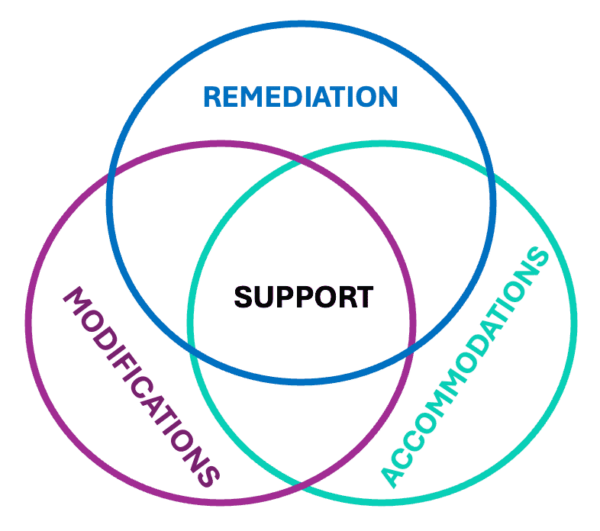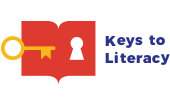Accommodations, Modifications and Assistive Technology for Students with Dyslexia

In addition to intervention instruction to improve literacy skills, students with dyslexia benefit from supports that help them learn independently. While they typically have the ability to grasp grade-level content, their literacy difficulties often hinder their progress, as much subject matter knowledge is accessed through reading and writing. The terms “accommodations” and “modifications” both refer to ways educators support students with dyslexia, but they serve distinct purposes and have different implications for teaching and learning (Cushen-White, 2020).
About Accommodations
Definition: Accommodations are modifications in how a student learns or demonstrates learning, without altering the content or expectations of the curriculum.
Purpose: To provide students with access to grade-level instruction and assessments by removing barriers caused by dyslexia.
Key Point: The student is not expected to complete less work or learn different content—only to learn in a way that better aligns with their learning profile.
Examples:
- Allowing extra time on tests or assignments
- Using assistive technology, such as spellcheck, word prediction software, and text-to-speech or speech-to-text tools
- Allowing oral responses instead of written ones
- Providing visual aids and charts to reinforce concepts and instructions
- Offering simplified and more specific instructions
- Providing note-taking support
Additional Information:
- Accommodations are designed to allow students to demonstrate knowledge, skills, and abilities without lowering performance expectations or altering what is being measured.
- Instructional accommodations ensure that students have access to the same material during instruction and meet the same academic expectations as their peers.
- Testing accommodations guarantee that a student’s knowledge is assessed, rather than their ability to communicate that knowledge in writing or read an assessment independently.
- Accommodations do not alter the content of instruction nor give students an unfair advantage.
About Modifications
Definition: Modifications refer to changes in what a student is expected to learn. They involve adjusting the curriculum to better align with the student’s current skill level. This may include different or reduced content, with lowered or altered expectations.
Purpose: To align instruction and assessment with a student’s abilities when grade-level content is not yet accessible, even with accommodations.
Examples:
- Assigning shorter or simpler reading passages
- Reducing the number of vocabulary terms to be learned
- Reducing the homework load
- Adjusting writing assignments to require fewer sentences or simpler structures
Key Point: Modifications change academic expectations, which may impact credit or eligibility for certain diplomas or programs.
Additional Information:
- Modifications are distinct from accommodations. While modifications alter what material is to be learned and tested, accommodations provide alternative ways for students to access the material without changing the content itself.
- Modifications to curriculum content, homework assignments, or assessments change both the nature of instruction and the expectations for what students are to learn. However, they still allow students to interact with their peers in the classroom and school setting.
- If the validity of a test item or the content of instruction is changed, it is considered a modification—not an accommodation. For example, dictating answers for an essay test would be an accommodation, but limiting the essay content to only a portion of the material would be a modification.
- In practice, students with dyslexia often benefit most from accommodations while receiving intervention for their reading difficulties. Modifications are typically used when a student’s disability is severe enough that, even with accommodations, the curriculum must be adjusted to match their current instructional level.
Keep the following in mind regarding accommodations and modifications:
- Accommodations must be tailored to meet each individual student’s educational needs; there is no one-size-fits-all plan that works for all students with dyslexia.
- Both accommodations and modifications should be revisited regularly as students with dyslexia progress through school, as their literacy needs may shift over time.
- Teachers should design accommodations collaboratively, with input from other educators, the student, and family members.
- The importance of classroom and testing accommodations increases as students’ workloads grow when they move into higher grades.
Assistive Technology
Assistive technology (AT) supports are accommodations that help students with dyslexia access instruction in all content areas. According to the Individuals with Disabilities Education Act (IDEA) of 2004 (U.S. Department of Education), assistive technology is defined as:
“any item, piece of equipment, or product system, whether acquired commercially off the shelf, modified, or customized, that is used to increase, maintain, or improve the functional capabilities of a child with a disability.”
This definition encompasses a wide range of devices and services designed to assist students with disabilities in performing tasks they might otherwise struggle with, enabling them to participate more fully in their education.
Appropriately chosen AT can support dyslexic students with reading and writing tasks. These supports can range from low-tech solutions, such as a pencil grip, to high-tech tools, like text-to-speech software.
There are three common forms of AT for students with dyslexia (Dawson et al., 2018):
- Preferences available within operating systems (called system preferences)
- Extensions for web browsers
- Apps
The available AT options in these categories are constantly evolving, so it is essential for educators to stay informed about what is available.
Additional Points About AT and Students with Dyslexia
- AT helps dyslexic students save time and overcome challenges, such as difficulty with word decoding, slow note-taking, and poor handwriting.
- AT provides access to grade-level texts through text-to-speech software and audiobooks.
- It aids students in expressing their thoughts through dictation (e.g., speech-to-text software), keyboards, word processing or word prediction software, and electronic spelling and grammar checkers.
- It is important to note that AT is not an intervention. Students typically do not improve their reading and writing skills simply by using these tools. They still require intervention to build upon their existing skills. However, while developing these skills, AT allows them to access higher-level reading material and express their ideas through writing.
Suggestions for Classroom Modifications
General Classroom:
- Provide lists and outlines of what will be taught during a lesson or throughout the day.
- Establish classroom rules and use checklists for procedures such as entering and leaving the classroom, working in small peer groups, asking for assistance, and submitting work.
- For board work: provide enough space when writing for students to clearly see the wording, and use different colors if possible. Ensure that the writing remains on the board long enough for students to read and copy.
- Help students monitor their learning progress regularly by using progress charts, self- and peer checklists, and ongoing informal individual feedback from the teacher.
- Provide note-taking support.
- Allow additional time to complete assignments and tests.
- Avoid using contests or prizes based on the amount of material read, rather than the time spent reading.
- Provide opportunities for students to work collaboratively with peers.
- Seating arrangements:
- Allow students to sit closer to displays and whiteboards, especially for tasks involving copying.
- Seat students near the teacher to ensure easier access to support.
- Seat students away from windows and doors to minimize distractions.
- Organizational supports:
- Explicitly teach planning and organizational skills.
- Use materials that aid in organization, such as color-coded folders and notebook dividers.
- Provide time and calendar organizers.
- Post daily and weekly schedules.
Classroom and Homework Assignments:
- Repeat instructions, provide them in several modalities (written, oral, visual), and offer more detailed directions.
- Brief students on key points before starting an assignment.
- Break tasks down into small, manageable steps and information.
- Use individual learning packets with clearly stated objectives for classroom and homework assignments.
- Include self-monitoring tools, such as checklists and rubrics.
- Provide daily and weekly assignment sheets or pads that are easy to read and share with parents. Ensure that homework assignments are written down correctly.
- Allow additional time for assignments that require reading and writing.
- When grading assignments, give credit for achievement as well as the finished product.
- Set time limits for homework assignments, recognizing that students with dyslexia may require more time to complete the same amount of work as their peers.
For Quizzes and Tests:
- Use more “open-book” assessments that allow students to access notes and texts.
- Allow extra time for completion.
- Offer alternative assessment methods, such as substituting assignments for quizzes or tests.
- Provide the option for students to listen to assessment questions (e.g., the teacher reads to the student or use of text-to-speech technology).
- Allow students to respond orally.
- Focus on the content of the assessment rather than penalizing for spelling mistakes.
For Writing Tasks:
- Provide speech-to-text technology.
- Use extra spacing between lines for handwriting tasks.
- Allow word-processing tools to replace handwriting.
- Spelling: Keep in mind that students with dyslexia find it difficult to proofread for spelling errors. Spelling errors and letter/numerical reversals or transpositions should not be marked wrong but should be pointed out.
For Reading Tasks:
- Avoid asking students to independently read text that is beyond their skill level. Instead, provide options for listening to text: have teachers or peers read aloud, use text-to-speech technology, or provide audiobooks.
- Avoid embarrassing students by asking them to read aloud in front of others. Always give them the option.
- Provide text in more accessible formats: larger print, more space between lines, and less text per page.
For Math:
- Allow the use of calculators.
- Highlight math symbols by circling computation signs or color-coding place value tasks.
- Use graph paper with large squares for place value and adding or subtracting multiple-digit numbers.
- Use dotted lines to line up math problems or mark margins.
- Provide manipulatives (objects to touch and move around) for hands-on learning.
References:
- Cushen-White, N. (2020). Accommodations for students with dyslexia. International Dyslexia Association. https://dyslexiaida.org/accommodations-for-students-with-dyslexia/
- Dawson, K., Antonenko, P, Lane, H, & Zhy, J. (2018). Assistive technologies to support students with dyslexia. Teaching Exceptional Children, 51(3).
- U.S. Department of Education. (2004). Individuals with disabilities education act. Public Law 108-446. https://www.congress.gov/bill/108th-congress/house-bill/1350/text

 Joan Sedita is the founder of Keys to Literacy and author of the Keys to Literacy professional development programs. She is an experienced educator, nationally recognized speaker and teacher trainer. She has worked for over 35 years in the literacy education field and has presented to thousands of teachers and related professionals at schools, colleges, clinics, and professional conferences.
Joan Sedita is the founder of Keys to Literacy and author of the Keys to Literacy professional development programs. She is an experienced educator, nationally recognized speaker and teacher trainer. She has worked for over 35 years in the literacy education field and has presented to thousands of teachers and related professionals at schools, colleges, clinics, and professional conferences.
Thank you for this detailed overview
Great work.
Thanks 🙏